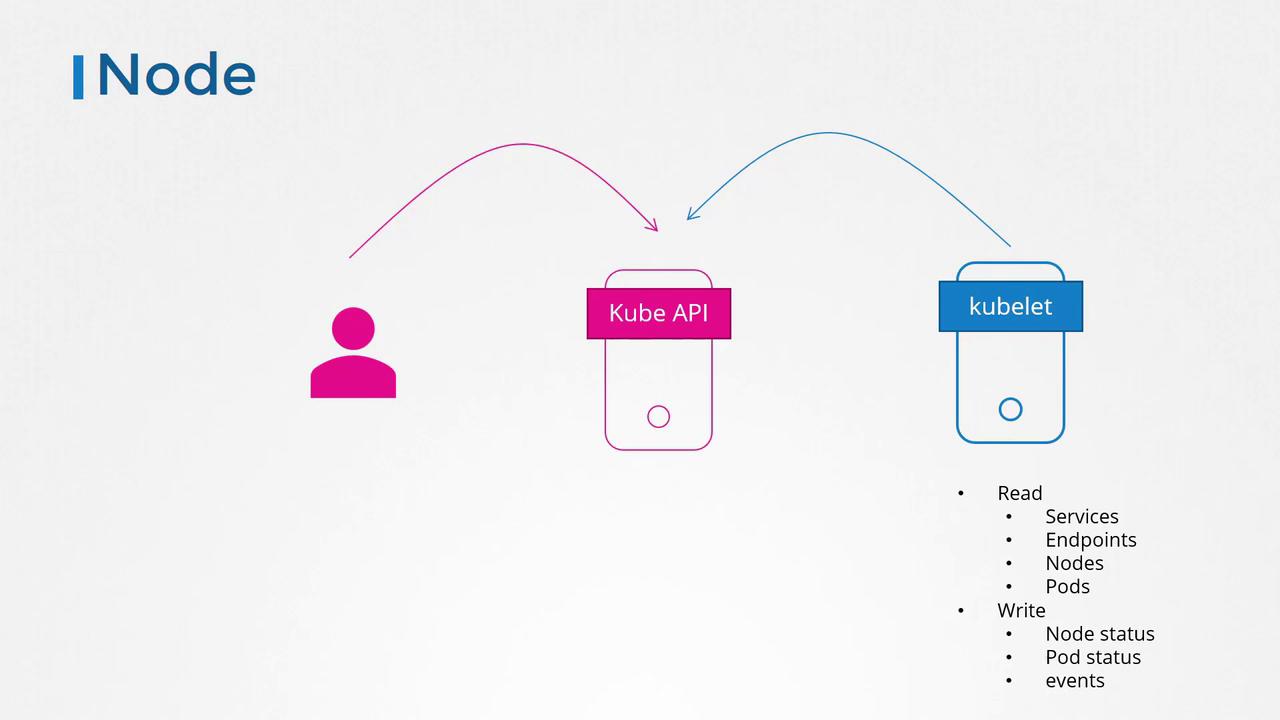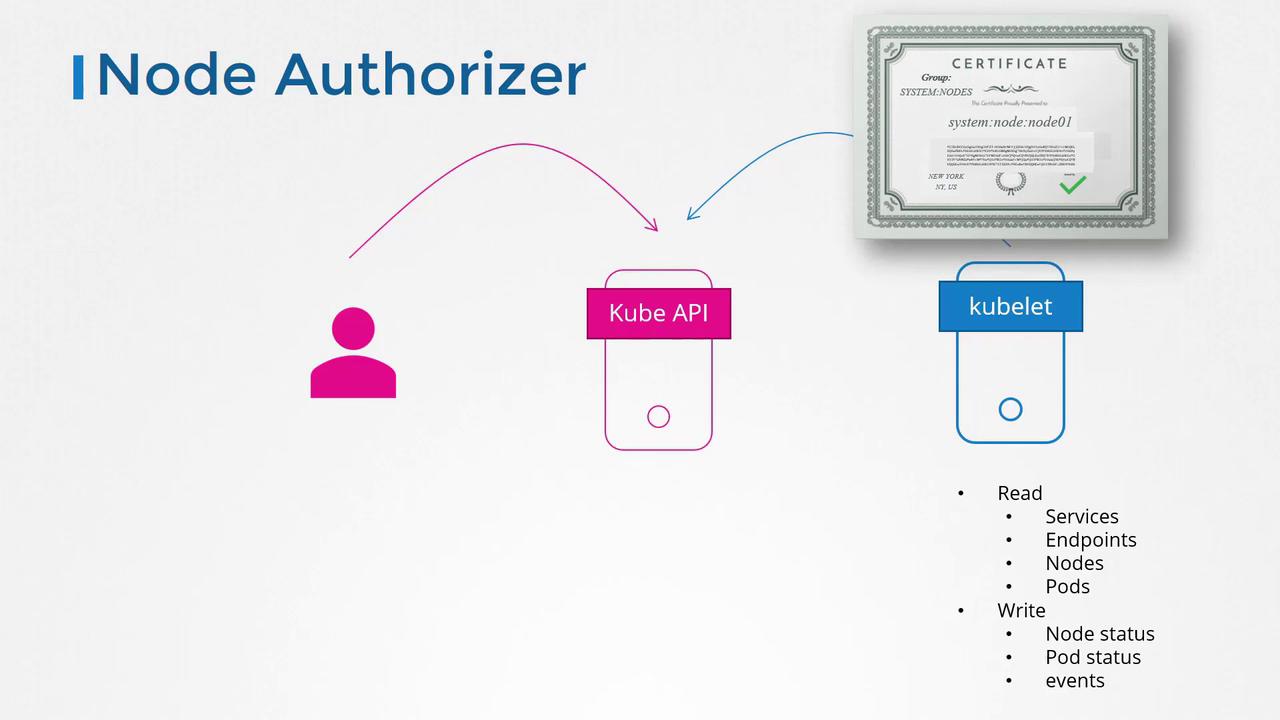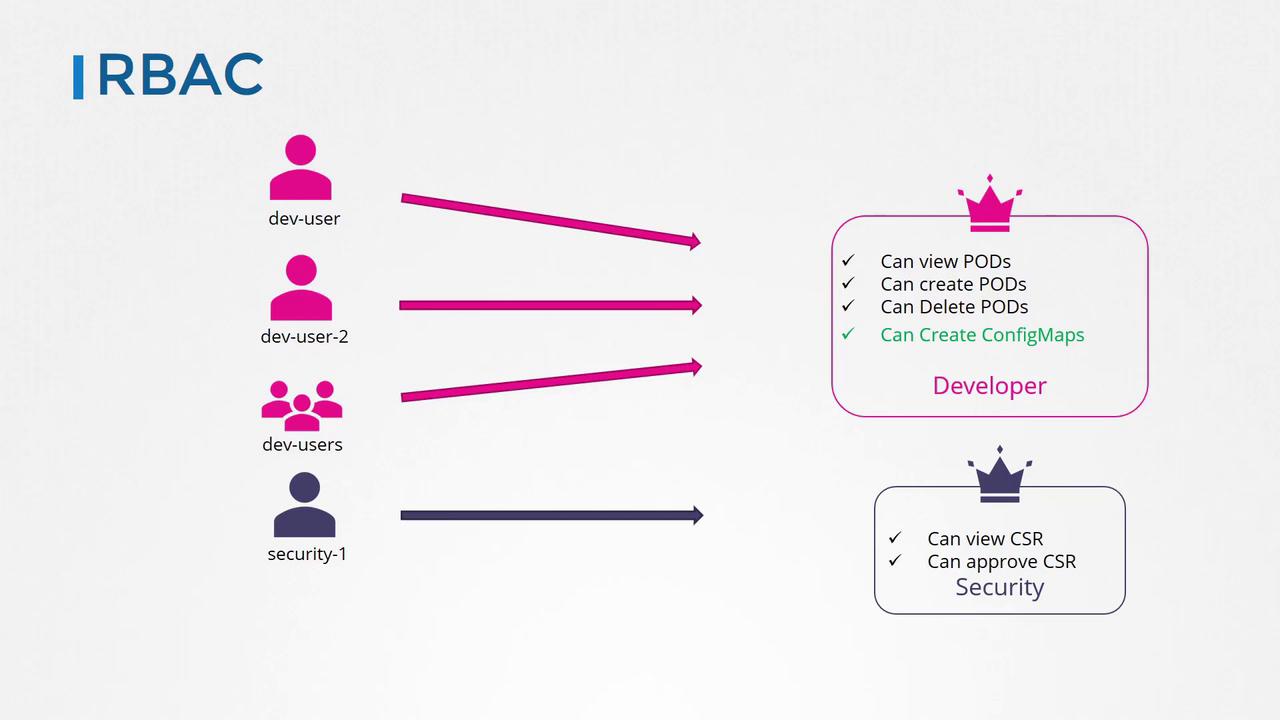CKA Certification Course - Certified Kubernetes Administrator
Security
Authorization
In this lesson, we explore how authentication allows individuals or machines to gain access to a cluster and how authorization subsequently defines what actions they can perform within that cluster. Once a user gains access, authorization ensures they only have the appropriate permissions for their role. For example, a cluster administrator can view various objects such as Pods, Nodes, and Deployments:
kubectl get pods
NAME READY STATUS RESTARTS AGE
nginx 1/1 Running 0 53s
kubectl get nodes
NAME STATUS ROLES AGE VERSION
worker-1 Ready <none> 5d21h v1.13.0
worker-2 Ready <none> 5d21h v1.13.0
kubec
Administrators have full control, allowing them to create or delete objects like Pods or Nodes. As the cluster scales and more users—including administrators, developers, testers, or external applications like monitoring tools and Jenkins—access the system, it is critical to provide only the access level necessary for each user’s role. For instance, developers might be limited to deploying applications without the ability to modify the overall cluster configuration.
Below is an example demonstrating operations executed with limited permissions:
kubectl get pods
NAME READY STATUS RESTARTS AGE
nginx 1/1 Running 0 53s
kubectl get nodes
NAME STATUS ROLES AGE VERSION
worker-1 Ready <none> 5d21h v1.13.0
worker-2 Ready <none> 5d21h v1.13.0
kubectl delete node worker-2
Node worker-2 Deleted!
In contrast, attempting similar operations without sufficient privileges results in the following responses:
kubectl get pods
Error from server (Forbidden): pods is forbidden: User "Bot-1" cannot list "pods"
kubectl get nodes
Error from server (Forbidden): nodes is forbidden: User "Bot-1" cannot get "nodes"
kubectl delete node worker-2
Error from server (Forbidden): nodes "worker-2" is forbidden: User "developer" cannot delete resource "nodes"
When sharing a cluster across different organizations or teams using namespaces, authorization restricts users to their designated namespaces. Kubernetes supports multiple authorization mechanisms, including:
- Node Authorization
- Attribute-Based Authorization
- Role-Based Access Control (RBAC)
- Webhook Authorization
The Kubernetes API Server is the central component accessed by both management users and internal components, such as kubelets, which retrieve and report metadata about services, endpoints, nodes, and pods. The communication between a kubelet and the API server is illustrated in the diagram below:

Requests from kubelets—typically using certificates with names prefixed by "system:node" as part of the system:nodes group—are authorized by a special component known as the node authorizer. The following diagram explains the authorization process for kubelet requests:

Note
Kubernetes supports several authorization strategies to meet diverse security requirements. Always select the most appropriate mechanism for your cluster’s needs.
Attribute-Based Authorization
Attribute-based authorization associates specific users or groups with a defined set of permissions. For example, you can grant a user called "dev-user" permissions to view, create, and delete pods. This is achieved by creating a policy file in JSON format and passing it to the API server. Consider the following example policy file:
{"kind": "Policy", "spec": {"user": "dev-user", "namespace": "*", "resource": "pods", "apiGroup": "*"}}
{"kind": "Policy", "spec": {"user": "dev-user-2", "namespace": "*", "resource": "pods", "apiGroup": "*"}}
{"kind": "Policy", "spec": {"group": "dev-users", "namespace": "*", "resource": "pods", "apiGroup": "*"}}
{"kind": "Policy", "spec": {"user": "security-1", "namespace": "*", "resource": "csr", "apiGroup": "*"}}
Each time security requirements change, you must manually update this policy file and restart the Kube API Server. This manual process can be tedious and set the stage for more streamlined methods such as Role-Based Access Control (RBAC).
Role-Based Access Control (RBAC)
RBAC simplifies user permission management by defining roles instead of directly associating permissions with individual users. For example, you can create a "developer" role that encompasses only the necessary permissions for application deployment. Developers are then associated with this role, and modifications in user access can be handled by updating the role, affecting all associated users immediately.
RBAC is considered the standard method for managing access within a Kubernetes cluster. The diagram below provides a visual representation of RBAC across different roles:

Further details on RBAC will be discussed in upcoming lessons.
External Authorization Mechanisms
If you prefer managing authorization externally rather than with built-in Kubernetes mechanisms, third-party tools like Open Policy Agent (OPA) are an excellent choice. OPA can handle both admission control and authorization by processing user details and access requirements sent via API calls from Kubernetes. Based on OPA’s response, access is either granted or denied.
AlwaysAllow and AlwaysDeny Modes
Kubernetes also supports two basic authorization modes:
- AlwaysAllow: Permits all requests without performing any authorization checks.
- AlwaysDeny: Denies all requests.
These modes are configured using the authorization-mode option on the Kube API Server and are crucial when determining which authorization mechanism is active. In cases where no mode is specified, AlwaysAllow is used by default.
Below is an example configuration using AlwaysAllow:
ExecStart=/usr/local/bin/kube-apiserver \\
--advertise-address=${INTERNAL_IP} \\
--allow-privileged=true \\
--apiserver-count=3 \\
--authorization-mode=AlwaysAllow \\
--bind-address=0.0.0.0 \\
--enable-swagger-ui=true \\
--etcd-cafile=/var/lib/kubernetes/ca.pem \\
--etcd-certfile=/var/lib/kubernetes/apiserver-etcd-client.crt \\
--etcd-keyfile=/var/lib/kubernetes/apiserver-etcd-client.key \\
--etcd-servers=https://127.0.0.1:2379 \\
--event-ttl=1h \\
--kubelet-certificate-authority=/var/lib/kubernetes/ca.pem \\
--kubelet-client-certificate=/var/lib/kubernetes/apiserver-etcd-client.crt \\
--kubelet-client-key=/var/lib/kubernetes/apiserver-etcd-client.key \\
--service-node-port-range=30000-32767 \\
--client-ca-file=/var/lib/kubernetes/ca.pem \\
--tls-cert-file=/var/lib/kubernetes/apiserver.crt \\
--tls-private-key-file=/var/lib/kubernetes/apiserver.key \\
-v=2
You can also specify a comma-separated list of multiple authorization modes. For example, to configure node authorization, RBAC, and webhook authorization, set the parameter as follows:
ExecStart=/usr/local/bin/kube-apiserver \\
--advertise-address=${INTERNAL_IP} \\
--allow-privileged=true \\
--apiserver-count=3 \\
--authorization-mode=Node,RBAC,Webhook \\
--bind-address=0.0.0.0 \\
--enable-swagger-ui=true \\
--etcd-cafile=/var/lib/kubernetes/ca.pem \\
--etcd-certfile=/var/lib/kubernetes/apiserver-etcd-client.crt \\
--etcd-keyfile=/var/lib/kubernetes/apiserver-etcd-client.key \\
--etcd-servers=https://127.0.0.1:2379 \\
--event-ttl=1h \\
--kubelet-certificate-authority=/var/lib/kubernetes/ca.crt \\
--tls-cert-file=/var/lib/kubernetes/apiserver.crt \\
--tls-private-key-file=/var/lib/kubernetes/apiserver.key \\
--v=2
When multiple modes are configured, each request is processed sequentially in the order specified. For example, a user’s request is first evaluated by the node authorizer. If the request does not pertain to node-specific actions and is consequently denied, it is then passed to the next module, such as RBAC. Once a module approves the request, further checks are bypassed and the user is granted access.
Summary
This lesson provided an in-depth look at authorization in Kubernetes—from basic attribute-based policies to advanced RBAC and external mechanisms. Choosing the right authorization methods is essential for securing your cluster while ensuring users have only the permissions they need.
That concludes this lesson on authorization. Stay tuned for further exploration of role-based access controls and other advanced authorization mechanisms.
Watch Video
Watch video content